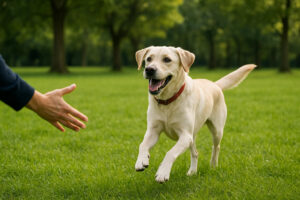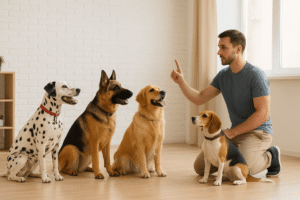The Ultimate Dog Training Guide 2025: Powerful Secrets to Obedient Companion
Dog training is one of the most rewarding investments you can make in your furry friend’s life. Whether you’re teaching a puppy the basics, refining commands for an adult dog, or correcting unwanted behavior, the right approach can make all the difference. In this comprehensive guide, we’ll explore proven methods, professional insights, and practical strategies that make dog training effective and enjoyable—for both you and your dog.
Why Dog Training Matters
Training your dog goes far beyond teaching “sit” or “stay.” It’s about building a strong bond, improving communication, and ensuring your dog can thrive in different environments. A well-trained dog is not only safer but also more confident, less anxious, and easier to integrate into family and social life.
Key benefits of dog training include:
- Strengthened relationship between you and your dog.
- Prevention of destructive behavior.
- Safety for both your pet and others.
- Easier socialization with humans and other dogs.
- Mental stimulation and physical activity.
Understanding Your Dog’s Behavior
Before learning training methods, it’s important to first understand how dogs think and behave. Dogs don’t misbehave out of spite; they act based on instinct, environment, and learned experiences. Recognizing the “why” behind the behavior helps you train more effectively.
Common behavioral triggers include:
- Boredom: Dogs may chew furniture or dig when they lack stimulation.
- Fear or anxiety: Barking excessively or hiding may signal stress.
- Territorial instincts: Guarding food, toys, or space is natural for some breeds.
- Lack of clear direction: Without guidance, dogs create their own rules.

Essential Principles of Dog Training
The foundation of every successful dog training program is built on consistency, patience, and positive reinforcement. Here are the pillars you should keep in mind:
1. Consistency
Use the same commands and signals every time. Inconsistent training confuses your dog.
2. Positive Reinforcement
Reward desired behavior with treats, praise, or play. Dogs respond better to rewards than punishment.
3. Patience
Some breeds and individual dogs take longer to learn. Stay calm and persistent.
4. Short Training Sessions
Dogs learn best in 5–10 minute sessions, repeated several times daily.
5. Clear Communication
Use a firm, calm voice and avoid shouting. Dogs respond to tone more than words.
Basic Dog Training Commands Every Dog Should Know
Every dog, regardless of age or breed, should master a few basic commands. These not only improve obedience but also ensure safety in public and at home.
- Sit – Foundation command for calmness.
- Stay – Prevents sudden movements in risky situations.
- Come – Ensures your dog returns to you, crucial for outdoor safety.
- Leave it – Prevents your dog from picking up harmful objects.
- Heel – Encourages controlled walking without pulling.
Dog Training Methods: Which One Works Best?
Different trainers and owners use various methods. Here are the most common approaches:
- Clicker Training: Uses a sound marker (clicker) to reinforce good behavior.
- Reward-Based Training: Focuses on treats, toys, and praise.
- Balanced Training: Combines positive reinforcement with gentle corrections.
- Modeling/Mirroring: Dog learns by observing other dogs or humans.
Puppy Training: Starting Early
The best time to begin training is when your dog is a puppy. Early training lays the foundation for lifelong habits.
Focus areas for puppies include:
- House training and potty training.
- Socialization with people and pets.
- Basic commands like sit, come, and stay.
- Crate training for safety and comfort.

Advanced Dog Training Techniques
After your dog has a solid grasp of the basics, you can begin teaching more advanced skills and fun tricks.
- Off-leash training for greater freedom.
- Agility training using obstacle courses.
- Guard dog training for certain breeds.
- Therapy or service dog training for emotional or medical support.
Common Dog Training Mistakes to Avoid
Even with the best intentions, owners sometimes make mistakes that slow progress. Avoid these pitfalls:
- Using punishment instead of guidance.
- Inconsistent rules (allowing jumping sometimes but scolding other times).
- Training when you or your dog are stressed.
- Skipping socialization during puppyhood.
- Expecting results overnight.
How Long Does Dog Training Take?
The timeline depends on factors like breed, age, consistency, and the complexity of commands. Puppies may learn “sit” in a day, while leash training could take weeks. On average, it takes 4–6 months for a dog to become reliably trained with daily practice.
Dog Training Tools and Equipment
The right tools make dog training more effective:
- Leash and harness for controlled walks.
- Clicker for marker training.
- Treat pouch for quick rewards.
- Interactive toys for mental stimulation.
- Crates and playpens for structure.
The Role of Socialization in Dog Training
Training is not just about commands—it’s also about exposing your dog to different environments, people, and animals. Proper socialization reduces fear, aggression, and anxiety.
Tips for socialization:
- Help your dog explore the world by gradually exposing them to different environments, sounds, and scents.
- Arrange playdates with other dogs.
- Visit pet-friendly cafes, parks, and stores.
- Gradually expose them to traffic, crowds, and noise.
Dog Training for Behavior Issues
Some dogs need extra training for problem behaviors like barking, digging, or chewing.
- Excessive Barking: Teach “quiet” command and remove triggers.
- Leash Pulling: Use a no-pull harness and reward walking calmly.
- Separation Anxiety: Gradually increase alone time, provide toys, and avoid long absences.
- Aggression: Seek professional help if the issue persists.
DIY Dog Training vs. Professional Trainers
Many owners successfully train their dogs at home, but professional trainers can help in tough cases.
DIY Training Pros:
- Strengthens your bond.
- Cost-effective.
- Flexible schedule.
Professional Trainer Pros:
- Expert handling of complex behaviors.
- Faster results with advanced techniques.
- Structured programs.

Keeping Training Fun and Engaging
Training should never feel like a chore. Make it fun with:
- Games like fetch with commands.
- Puzzle toys as rewards.
- Mixing up environments to keep dogs alert.
- Celebrating small wins with affection.
The Science Behind Dog Training
Dog training is not just about commands—it’s rooted in behavioral science. Understanding how dogs learn helps you apply techniques more effectively.
Operant Conditioning
This is the basis of most dog training methods. It involves four main quadrants:
- Positive reinforcement (adding a reward for good behavior).
- Negative reinforcement means taking away something unpleasant once your dog responds correctly.
- Positive punishment is when you add something your dog doesn’t like—such as saying a firm “No”—to stop unwanted behavior.
- Negative punishment (removing something enjoyable, such as stopping play).
Professional trainers generally recommend focusing primarily on positive reinforcement, as it builds trust and long-term results.
Breed-Specific Training Approaches
Different breeds learn differently because of their instincts, energy levels, and temperaments. By recognizing your special breed dog’s traits, you can adjust your training methods to suit them better.
-
Border Collies & German Shepherds: Highly intelligent, require mental challenges and advanced training.
-
Beagles & Hounds: Strong scent drive; need recall training reinforced with high-value treats.
-
Labrador Retrievers & Golden Retrievers: Eager to please, respond quickly to reward-based methods.
-
Terriers: Stubborn and energetic, benefit from short, playful training sessions.
-
Small breeds (Chihuahua, Pomeranian): Require consistency in house training and handling confidence issues.
Crate Training: A Powerful Tool
Many people misinterpret crate training, but when introduced properly, it provides a secure and comforting space for your dog.
Benefits of crate training:
- Helps with potty training.
- Provides a safe, den-like space.
- Reduces anxiety during travel.
- Prevents destructive behavior when unsupervised.
Tips:
- Never use the crate as punishment.
- Make it inviting with blankets and toys.
- Start with short sessions and gradually increase time.
Training Dogs with Special Needs
Not all dogs learn at the same pace—some have physical or behavioral challenges.
- Deaf dogs: Use hand signals instead of voice commands.
- Blind dogs: Train with verbal cues and scent markers.
- With rescue dogs: That have experienced trauma, focus on earning their trust gradually and avoid pushing them too quickly.
- For older dogs: Keep training calm and brief, placing emphasis on mental stimulation and gentle activities.
Group Training Classes vs. One-on-One Training
Both group and private sessions have their pros and cons.
Group Training
- Socializes your dog.
- More affordable.
- Good for basic obedience.
One-on-One Training
- Personalized approach.
- Ideal for behavior problems.
- More flexibility with scheduling.
A good approach is to begin with group classes for social skills, then move to one-on-one sessions if specific problems come up.
Dog Training for Different Life Stages
Dogs require different approaches at different ages.
- Puppyhood (8 weeks–6 months): Focus on socialization, crate training, potty training.
- Adolescence (6 months–2 years): Address stubbornness, reinforce obedience, practice leash manners.
- Adulthood (2–7 years): Continue training to avoid boredom, introduce advanced commands.
- Senior years (7+ years): Adapt training to mobility, focus on mental stimulation and gentle activities.

Mental Stimulation: Training Beyond Commands
Training is not only physical—it’s also mental. Dogs thrive when their brains are engaged.
Ways to keep your dog mentally sharp:
- Puzzle toys and treat-dispensing games.
- Teaching new tricks regularly.
- Scent work (hide treats around the house).
- DIY agility courses in the backyard.
Reward Types in Dog Training
Not all rewards work equally for every dog. Identifying what motivates your pet is key.
- Food Rewards: Treats, kibble, or small pieces of cheese.
- Toy Rewards: Tug ropes, balls, or squeaky toys.
- Affection Rewards: Verbal praise, belly rubs, petting.
- Life rewards: Can be simple joys like going for a walk, having playtime, or enjoying time in the yard.
Expert Tip: Use a variety of rewards to keep your dog engaged and make every training session enjoyable.
Real-Life Dog Training Success Stories
Hearing how other owners succeeded can inspire you.
- Case Study 1: Leash Puller Turned Calm Walker
A Labrador that constantly pulled on walks learned to walk calmly using a no-pull harness and clicker training in 3 months. - Case Study 2: Rescue Dog Overcoming Fear
A rescue German Shepherd overcame separation anxiety through gradual alone-time training and puzzle toys. - Case Study 3: Senior Dog Learns New Tricks
An 8-year-old Beagle learned scent games that improved confidence and mental sharpness.
Technology in Dog Training
Modern dog owners are using technology to make training easier.
- Smart Collars: Track activity and location.
- Training Apps: Provide structured programs and reminders.
- Interactive Cameras: Let you monitor and train remotely.
- Automatic Treat Dispensers: Reinforce behavior even when you’re away.
Final Golden Rules for Dog Training
- Train daily, even if only for 5 minutes.
- Always end sessions on a positive note.
- Adjust training to your dog’s personality.
- Celebrate progress, even small wins.
- Remember that patience and love are the strongest tools.
Final Thoughts on Dog Training
Dog training is not just about obedience—it’s about trust, communication, and creating a life full of joy for your pet. With patience, consistency, and the right approach, you can turn challenges into triumphs and nurture a dog that is not only obedient but also confident and happy.
Remember: Every dog learns at its own pace, and every training session is an opportunity to strengthen your bond.
